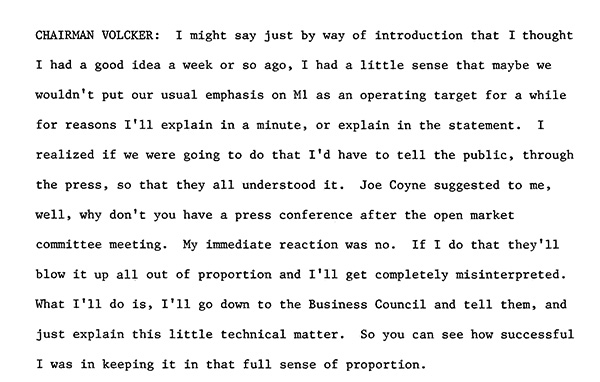On March 24, 2011, the Federal Reserve announced that Chairman Bernanke would hold quarterly press conferences coinciding with the Federal Open Market Committee (FOMC) meetings where participants submit their economic projections. The first of these press conferences was held April 27 of that year, and a full transcript was released to the public. These quarterly press conferences continued under Chair Yellen, with a press conference held after four of the eight regularly scheduled yearly meetings. On June 13, 2018, Chairman Powell announced he would begin holding press conferences after every FOMC meeting beginning January 2019. While the Federal Reserve regularly releases statements announcing monetary policy, until the change in 2011, it was unusual for a Federal Reserve Chair to hold a press conference.
These modern press conferences are a conscious effort to make the business of the Federal Reserve—and the FOMC specifically—more transparent to the public. Federal Reserve officials have been discussing the benefits of greater public transparency since at least the late 1990s. Although Fed officials from across the Federal Reserve System have given public statements on policy and operations since the Federal Reserve Banks opened in 1914, the trend since the 1970s[1] (partially due to congressional pressure) has been to make more monetary policy information available to the public earlier and earlier.[2]
While 2011 marks the beginning of the first regularly scheduled press conferences, they are not the first in Fed history. Searching FRASER for “press conference” in the “Statements and Speeches of the Chair of the Board of Governors” collection, one can find earlier examples of press briefings, typically following an important change in policy. For instance, Paul Volcker held only three press conferences in his tenure as Chair. The first, held at 6 p.m. on Saturday October 6, 1979, announced unscheduled monetary policy reform (a move often known as the “Saturday Night Special”). The second, just three days later at the American Bankers Association conference on October 9, 1979, further explained the change. The third, exactly three years later, explained a change in the FOMC’s decisionmaking process:

The longest serving Chair, William McChesney Martin Jr., held two press conferences that we’ve been able to identify. One on November 23, 1964, explained a change in the discount rate in response to actions taken by the Bank of England. The other, on August 17, 1965, explained the current state of the balance of payments in the wake of President Johnson’s February 1965 balance of payments directive to Congress. In addition, Chair Martin would occasionally release statements to the press.
The oldest press conference material in the collection is from Marriner S. Eccles, Chairman of the Board of Governors from 1934-1948. The text describes a press conference given on February 8, 1935, in which he discusses “proposals for changes in our banking laws”—specifically changes to Fed structure and open market operations that would become law that August with the Banking Act of 1935. Interestingly, the text also refers to his “regular Friday press conference,” suggesting there were many others given in that time. Unfortunately, we do not have any documents describing those press conferences in FRASER. Eccles’s conferences were likely a response to the U.S. banking crisis experienced at the time.
Explore more of the history of monetary policy communications in the FRASER collection “Statements and Speeches of Federal Open Market Committee Participants,” 1936-present.
[1] See the “Detailed Description of Documents Available” section on the FOMC webpage “Transcripts and Other Historical Materials.”
[2] For an in-depth look at FOMC communications, see the book-length report “A Modern History of FOMC Communication: 1975-2002,” created for internal use in 2003 and released by the FOMC in 2009.
© 2019, Federal Reserve Bank of St. Louis. The views expressed are those of the author(s) and do not necessarily reflect official positions of the Federal Reserve Bank of St. Louis or the Federal Reserve System.
